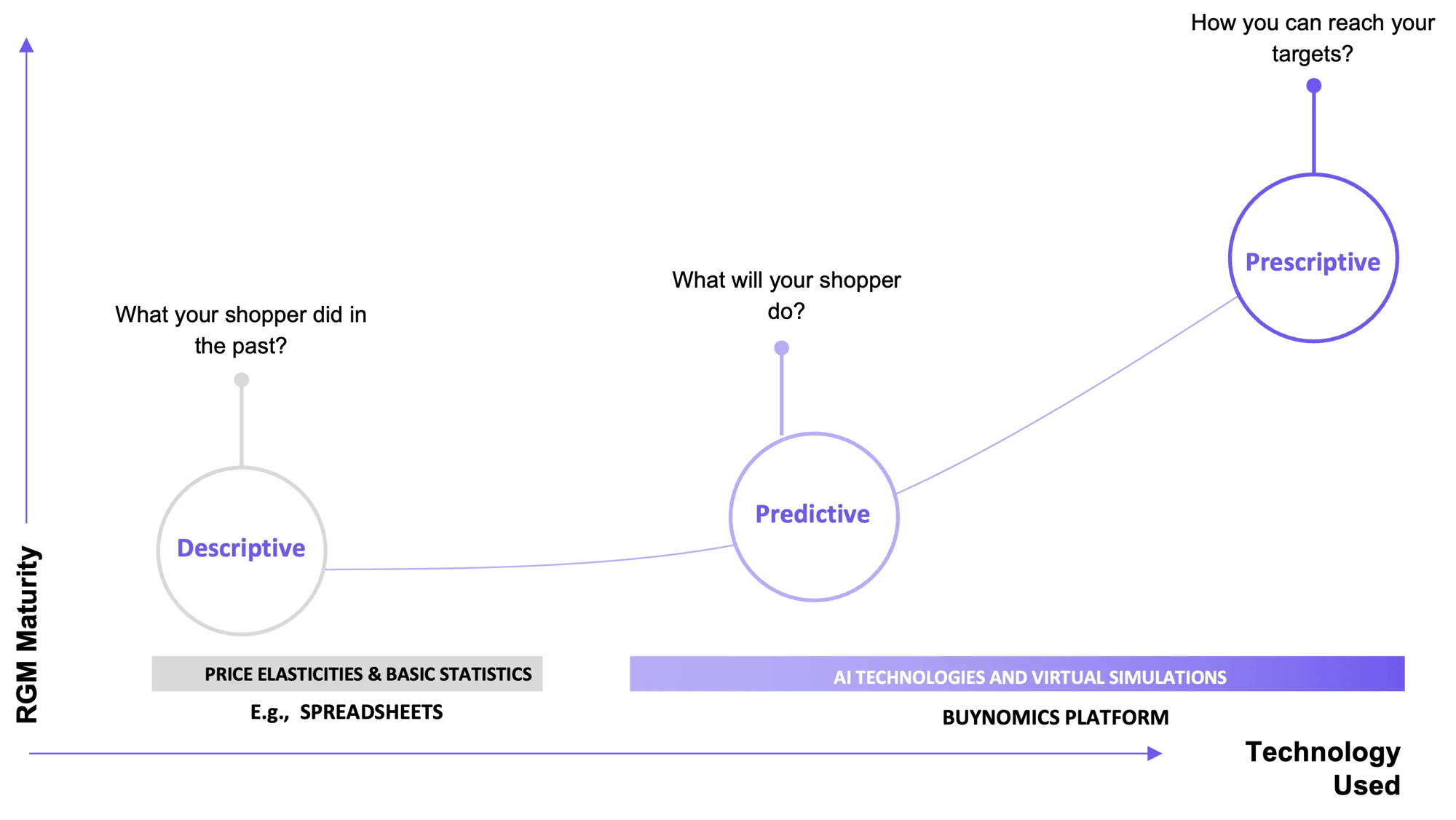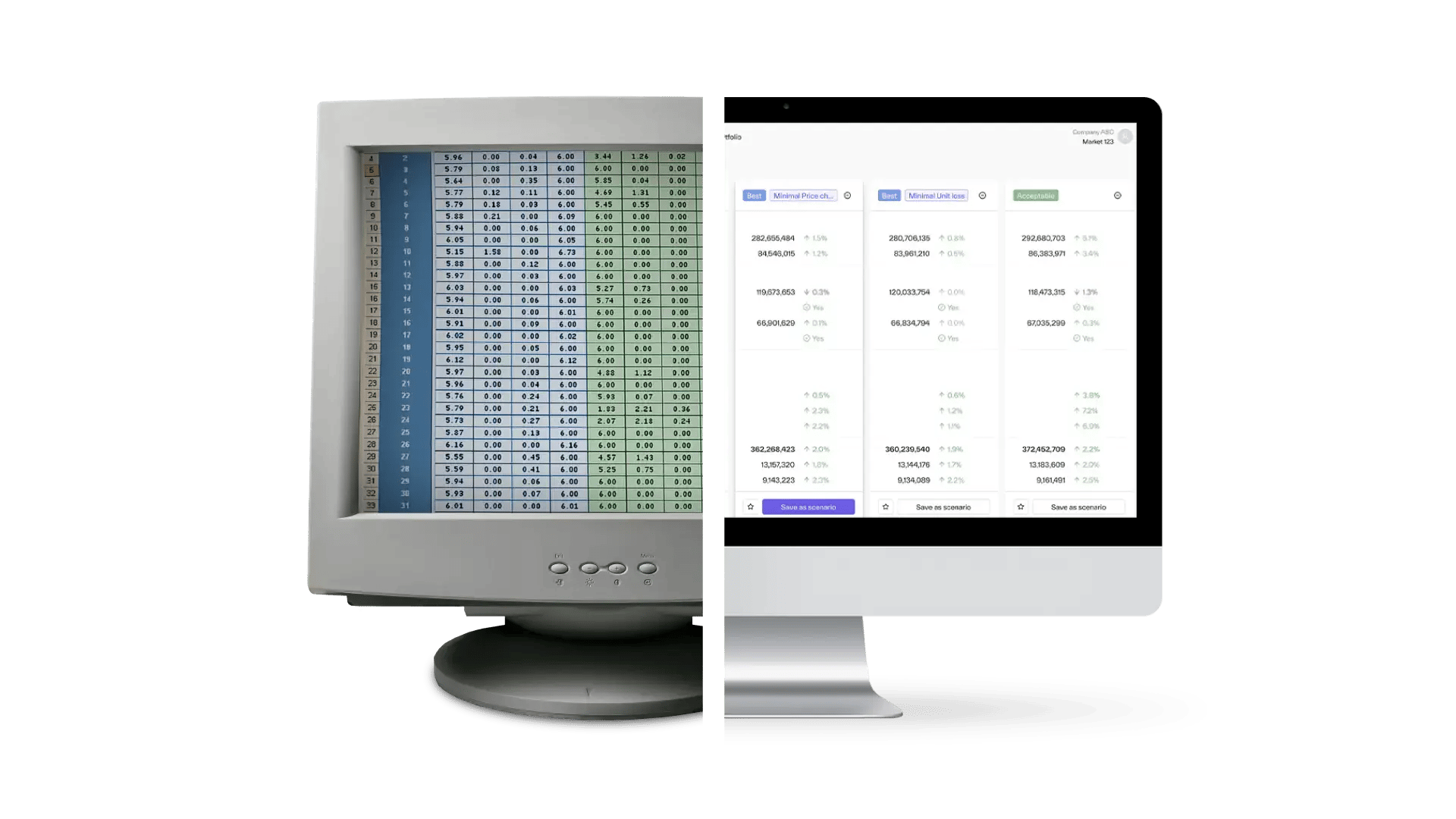Revenue Growth Management Redefined
Going from Descriptive to Prescriptive Analytics
Revenue Growth Managers today are tasked with a complicated assignment: to holistically steer their brand’s portfolio with certainty and speed while considering all the different constraints and KPIs. At the same time, they must meet various needs and requirements from marketing, sales, supply chain, and other departments across the organization and, of course, the retailers.
This must be done in an era when market dynamics continuously shift due to general inflation, partly massively increased raw materials costs (e.g., cocoa), and changed consumer preferences (e.g., return of the smart shopper).
At Buynomics, we know it's harder than ever to make the right pricing decisions to achieve revenue targets. Buynomics' end-to-end revenue optimization platform has empowered some of the biggest CPG brands, including Unilever, Danone, and others, to make commercial decisions based on one single source of truth—their shoppers.
This approach is a scalable and transparent way to advance Revenue Growth Management (RGM) strategy and transition from descriptive analysis done in spreadsheets to predictive "What will happen?" and ultimately to prescriptive, targeted actions that answer the "How can we make it happen?" question.
Key Stages of Revenue Growth Maturity
In a survey done by Buynomics, we found that most revenue managers currently use a combination of predictive and descriptive analytics, with only 23% focusing on prescriptive analytics. This indicates a significant opportunity for growth and improvement in leveraging prescriptive analytics to drive more informed and action-oriented decision-making and optimized outcomes.
In many scientific fields, a transition from descriptive to prescriptive occurred as the disciplines matured. Scientists no longer looked at what was happening but instead wanted to understand what would happen and why.
The key is to understand the underlying dynamics that cause the observed phenomena. Astronomy took a big step forward when Newton discovered the laws of gravity as the basis for the movement of the planets. We will see that these underlying dynamics in RGM are shopper preferences.
In this article, we review the complex RGM maturity journey to help leaders transform their RGM departments.

Never-ending Descriptive Analysis
Pricing is about getting ALL the details right to make a massive impact across the top and bottom lines. RGM departments often need to consider several constraints when forming their pricing strategies. For example, when calculating the optimal price for profit maximization, a manufacturer might need to take into account the following factors:
- Maintaining a minimum margin of 20%,
- Pricing items at 5% below competitors, and
- Ensuring the sale of at least 10,000 units of a particular product to avoid supply chain disruptions.
Is it possible to price this product effectively with traditional RGM tools based on descriptive analysis? The short answer is no.
Traditional RGM tools often fail because they rely heavily on historical data and generic market models, limiting their effectiveness. They might offer hypothesis testing based on historical consumer habits that help assume the correct strategy. But how many of these hypotheses can be run at the same time, and how many KPIs and RGM levers can it take into consideration?
Traditional RGM tools simply can't provide a comprehensive, forward-thinking analytical approach to RGM strategy in a short time span that considers all RGM levers, cross-effects, KPI targets, and constraints.
Descriptive analytics powered by traditional RGM practices force revenue growth managers to base their decisions partly on gut feeling (e.g., guessing or ignoring cannibalization and competitor interaction) rather than making data-driven decisions based on insights into what shoppers will buy.
Predictive Analytics – What Will Happen?
Maturing in Revenue Growth Management means transitioning from describing what happened to predicting what will happen or impact shopper behavior. At the same time, revenue growth managers should be able to understand how the bigger picture will look after making the change.
A modern, forward-thinking RGM manager needs the right tools. Otherwise, at some point, brands might start losing market share to a competitor or a new brand on the supermarket shelf that actually figured out what shoppers will buy and offers the product based on all RGM levers.
That is where Buynomics’ platform comes in.
Powered by our Virtual Shopper AI technology, we help RGM departments answer the question, “What will your shoppers buy?” Buynomics’ cutting-edge technology simulates a virtual supermarket shelf where millions of Virtual Shoppers react to both stand-alone and combined changes in PPA, pricing, promotions, and mix.
Buynomics’ AI creates millions of Virtual Shoppers that mimic the preferences and reactions of real shoppers with unrivalled precision, based on existing data.
With instant feedback from these shoppers on how their real-life counterparts would react to price, PPA, promotion, or mix changes, RGM teams can quickly evaluate the impact of any potential changes on all relevant KPIs.
Buynomics’ technology enables RGM teams to test various scenarios and see potential market outcomes without risk, quickly considering all cross effects to optimize market share and profitability.

Prescriptive Analytics – How Can We Make It Happen?
The Revenue Growth Management discipline is currently undergoing an evolution and maturing as it moves from descriptive analytics (how do certain things work?) to predictive analytics (how will the market react?) and finally reaches the prescriptive level (how can we make it happen?)
Prescriptive analytics consists of three aspects:
- Prediction - it can predict how price, promotion, PPA changes affect sales, revenue, and profit.
- Recommendation - it has the ability to recommend changes that optimize KPI or help achieve strategic goals and navigate through the myriad of potential options to identify the ones best suited for strategic goals.
- Reasoning - it provides full transparency on why specific changes were recommended (For example, variations in context-specific elasticity, the proximity between products, or changes in costs).
In less mature RGM organizations, we often see RGM managers working with a black box or numerous spreadsheets where the answer to “what is happening” and “why” is lost. An approach like this eventually leads to poor decision-making and can negatively impact revenue calculations.
Buynomics’ approach is simple: When running different calculations, the RGM manager needs to understand the dynamics of the system, trust the system, and work with the results. All of this directly influences the quality of the outcome and the acceptance of change within the organization.
The search for prediction, recommendation, and explanation led Buynomics’ founders Ingo Reinhardt and Sebastian Baier to develop the Virtual Shopper method for Revenue Growth Management years ago. We at Buynomics want to help RGM teams move away from ‘black-box’ methods and towards understanding what their shoppers will do in front of the supermarket shelf, putting these insights into the center of all RGM decisions.
Strategy Meets Science
Recently, we added a new module to the Buynomics platform: the Decision Guide. It empowers RGM managers to shift their strategic planning from predictive to prescriptive.
Buynomics’ Decision Guide puts KPI targets at the forefront of the revenue growth strategy.
It allows RGM managers to shift from: “What KPI impact X has changed Y” to “What is the best change Y to achieve KPI impact X, taking into account constraints Z”.
The tool simulates countless pricing decisions to find the best decision based on your set KPIs. It helps RGM managers understand the best decision to make depending on market conditions and competition moves, ultimately providing the best scenarios.
It does that by identifying and providing recommendations on differentiated price optimization potential for the entire portfolio. At the same time, it allows you to implement relevant guardrails such as capacity constraints, price ladder input, and others. To ensure competitive advantage, the Decision Guide includes competitor reactions for best response definition based on all market participants.
It is not a black box that gives you only one best answer. It offers a spectrum of options. You can break down the scenarios by granularity (per retailer, week, region, category, etc.) and KPI level (manufacturer, retailer, etc.) to ensure you meet all business objectives.
Buynomics' Decision Guide guides users through the process and results with easy-to-use dashboards and visualizations that RGM managers can plug into their conversations and presentations.
Decision-Making in Real Time
Focus groups and consultancy firms that help with RGM strategies can partially help to understand what customers will do. However, it is an expensive and time-consuming process that does not always provide you with timely information to make an effective and revenue-driving decision.
On the other hand, Buynomics’ platform and the Decision Guide together can answer the questions of what your customers will do and predict how you can make it happen the same day.
It helps RGM leaders move quickly from what-if scenarios to definitive action plans, aligning decisions with short-term needs and long-term objectives to outperform KPIs.
The Decision Guide transforms the speed and efficiency of decision-making processes, substantially reducing the time and effort required to analyze and implement RGM strategies.
Thanks to Buynomics’ powerful AI-driven simulations and optimizations, what previously required hundreds of hours of analysis from top-notch analysts can now be accomplished with the click of a button.
By automating complex analyses and providing actionable insights, the Decision Guide empowers RGM teams to focus on strategy instead of analysis, reduces the margin for error, and maximizes impact with minimal effort.
Get Started Today to Reach Your Goals Tomorrow
With Buynomics, it only takes weeks for RGM leaders to transform their departments from descriptive to prescriptive. Our team is here to support and guide RGM teams through every step.
To start, fill in our RGM maturity assessment to receive a personalized report in minutes. In this report, we will benchmark your performance in key categories and provide you with best practices and actionable next steps!
Stay ahead of the competition! Let’s talk about how the Buynomics platform can transform your RGM strategy today.
Request a demo today to see how Buynomics supports your RGM team and helps you make data-driven decisions.

July 18, 2024

